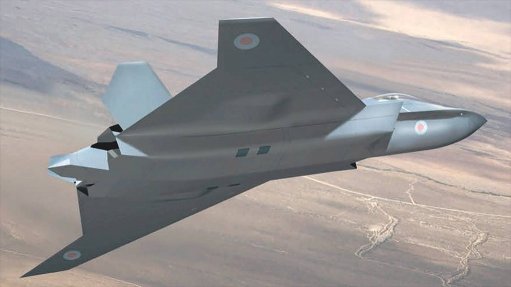
An artist’s impression of a “Team Tempest” design aircraft in flight
Photo by: UK Ministry of Defence
The UK unveiled a full-scale mock-up of a sixth-generation combat aircraft on the first day of the Farnborough airshow on Monday. This, described as a “concept aircraft”, is the result of the work of a consortium called Team Tempest, which is made up of British aerospace firms and the Royal Air Force Rapid Capabilities Office. The major companies concerned are BAE Systems, Rolls-Royce, Leonardo UK (the British subsidiary of the Italian Leonardo Group, previously Finmeccanica) and MBDA UK (part of the pan-European MBDA Group).
The sixth-generation will be the next generation of combat aircraft. The current leading-edge technology generation of combat aircraft is the fifth-generation, of which only two types, both American, are in full operational service: the Northrop Grumman B-2 Spirit bomber and the Lockheed Martin F-22 Raptor fighter. Other fifth-generation types are just entering service (the Lockheed Martin F-35 Lightning II and China’s Chengdu J-20) or are still under development (such as Russia’s Sukhoi Su-57).
The mock-up is the first public display of progress being made in Britain’s Future Combat Air System Technology Initiative (FCAS TI), which was launched in 2015. Team Tempest is implementing the FCAS TI, which is being funded to the tune of £2-billion over ten years (2015-2025). Within the team, BAE Systems is responsible for advanced combat air systems and integration, Roll-Royce for advanced propulsion and power systems, Leonardo for advanced avionics, electronics and sensors, and MBDA for advanced weapon systems. However, the programme is most certainly open to participation by international partners.
The UK Ministry of Defence (MOD) has now established a specific team to execute the future combat aircraft acquisition programme. It will conclude a “business case” by the end of this year. Initial decisions on international partners will be made by the middle of next year, with discussions starting at once. “Early decisions around how to acquire the capability will be confirmed by the end of 2020, before final investment decisions are made by 2025,” stated the MOD in its press release. “The aim is then for a next generation platform to have operational capability by 2035.”
The unveiling of the concept mock-up was accompanied by the launch of the MOD document 'Combat Air Strategy: An ambitious vision for the future' by Defence Secretary (Minister) Gavin Williamson. This paper includes a heavy focus on the aerospace industry and technology, including the opportunities for the British economy and industry presented by the development of new aerospace technologies (including engines, weapons systems and software architectures).
“We have been a world leader in the combat air sector for a century, with an enviable array of skills and technology,” he said in his address. “[T]his concept model is just a glimpse into what the future could look like. [The] British defence industry is a huge contributor to UK prosperity, creating thousands of jobs in a thriving advanced manufacturing sector”.